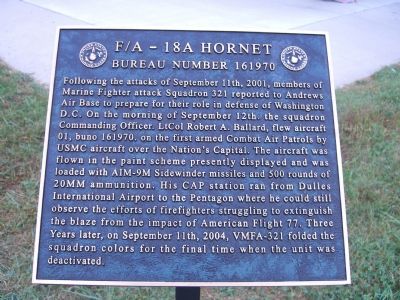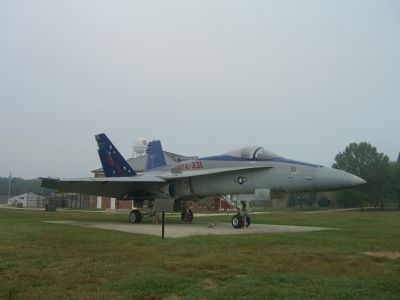Near Stafford in Stafford County, Virginia — The American South (Mid-Atlantic)
F/A – 18A Hornet
Bureau Number 161970
Erected 2005 by the United States Marine Corps.
Topics. This historical marker is listed in these topic lists: Air & Space • War, Afghanistan. A significant historical date for this entry is September 11, 1838.
Location. Marker is missing. It was located near 38° 29.92′ N, 77° 26.289′ W. Marker was near Stafford, Virginia, in Stafford County. Marker was on Gilbert Road, on the right when traveling west. Touch for map. Marker was in this post office area: Stafford VA 22556, United States of America. Touch for directions.
Other nearby markers. At least 8 other markers are within walking distance of this location. Gonzalez Hall (about 300 feet away, measured in a direct line); William Groom Leftwich, Jr. (about 300 feet away); Raider Hall (about 300 feet away); Heywood Hall (about 400 feet away); 6th Marine Division Medal of Honor Recipients (about 400 feet away); 13th Special Basic Course (1952) (about 400 feet away); First Special Basic Class (about 400 feet away); Quantico Marine Athletes of the Sixties (about 400 feet away). Touch for a list and map of all markers in Stafford.
Also see . . .
1. 9/11 Marine Fighter Jet Dedicated. First Marine Corps aircraft used in support of the war on terrorism is dedicated at The Basic School in Quantico, Va. (Submitted on October 8, 2007, by Kevin W. of Stafford, Virginia.)
2. Hornet's final flight hits skids at Quantico. An article in Fredericksburg, VA's The Free-Lance Star by Pamela Gould published on 9/21/2004. (Submitted on October 8, 2007, by Kevin W. of Stafford, Virginia.)
3. Plane trucked for restoration. The plane was placed at TBS since 2004, but was removed in March 2012 to refurbish it in time for future display inside the National Museum of the Marine Corps. The fighter jet is expected to be back on display to the public in 2017, after the Museum's second phase of expansion. (Submitted on August 9, 2013, by Kevin W. of Stafford, Virginia.)
Additional commentary.
1. A bittersweet ending for the ‘Hell’s Angels’
Reserve squadron deactivates as part of Navy-Marine tac-air integration
By Christian Lowe
Times staff writer
From an article published in The Marine Corps Times newspaper on October 11, 2004.
It didn’t really end as most had hoped it would.
As his aircraft skidded off the runway at Quantico, Va., the commander of Marine Fighter Attack Squadron 321 must have realized how inauspicious the end turned out to be.
As the F/A-18A Hornet plowed through the security fence and Lt. Col. William D. Reavis pulled the ejection handle, the door shut on a storied Reserve fighter squadron that was a short afterburner ride from the U.S. Capitol and the White House.
The Sept. 20 accident at Quantico involved a jet that spent much of Sept. 12, 2001, patrolling the skies over Washington. The plane was due to live out its retirement on display at the base, and it was the last official flight of the squadron.
“That’s never a good way to go out,” said Col. Mike Monroe, commander of Marine Aircraft Group 49, which oversees VMFA-321. “Last flight of the [commanding officer], last flight of the squadron, and, to be a mishap, that’s unfortunate.”
The Hornet is still salvageable and will likely go on display once it’s refurbished, Monroe said.
The squadron, known as the “Hell’s Angels,” was formally deactivated Sept. 30, a casualty of the Navy and Marine Corps’ new tactical aviation integration plan.
The plan calls for the deactivation of a Reserve Hornet squadron from both the Navy and Marine Corps, along with three active-duty Navy squadrons. Navy and Marine Corps officials say the move will cut overall aviation costs and make better use of the two services’ aviation resources.
The squadron, headquartered at Andrews Air Force Base, Md., took part in a 10-hour-long combat air patrol over Washington and its suburbs on Sept. 12, 2001. The Hell’s Angels relieved tired Air National Guard and Air Force pilots who had maintained a protective air cover above the city nonstop following the Sept. 11 terrorist attacks.
Nevertheless, in June 2004, Navy and Marine officials decided that VMFA-321 would be the Marine Reserve squadron to get the ax — not much time for the unit’s Marines to get affairs in order and move out by the end of September, Monroe said.
“The hard part of it is, this is a process that normally takes place over the course of a couple years,” Monroe said. “The pace was really high around there, and they didn’t have a lot of time to think.”
A financial decision
Marine officials said the decision to deactivate VMFA-321 was based on “operational effectiveness, contribution to the Marine Corps mission, personnel and equipment issues, as well as fiscal considerations,” according to a written response to questions from Marine Corps headquarters.
Spokesmen for Navy Secretary Gordon England and Marine Corps headquarters declined to provide more specific reasons for the decision to cut the squadron. The Corps maintains three additional Reserve Hornet squadrons: VMFA-112 in Fort Worth, Texas, VMFA-142 in Marietta, Ga., and VMFA-134 at Marine Corps Air Station Miramar, Calif.
All of the nearly 225 Marines from the now-defunct VMFA-321 have found a new home at other Reserve or active-duty units. The maintainers, most of whom are active-duty enlisted Marines, were transferred to other squadrons, while enlisted reservists were reassigned to drilling units — with some receiving new job training to fit the needs of their new unit.
The pilots found flight billets at one of the three remaining Reserve Hornet squadrons or in training squadrons. Some were reassigned to the Marine Aviation Support Detachment at Andrews, which flies the UC-35 Citation and the C-12 Huron logistics support planes.
Losing the Hell’s Angels might be quite a blow to the men and women who served in the squadron, but it’s not putting Monroe’s MAG under much strain. While the squadron was activated shortly after Sept. 11 for combat air patrol duty, VMFA-321 hadn’t deployed for operations in Afghanistan or Iraq. And since MAG-49 is a helicopter-heavy group, it was unlikely that the group would have deployed with the Hornets anyway, Monroe said.
Marine Reserve officials have hinted that their Hornet squadrons’ days may be numbered. None of the three remaining Reserve Hornet squadrons has been mobilized for war since Sept. 11, while several Reserve helicopter squadrons and KC-130 Hercules refueler-transport detachments have spent months plying the Middle Eastern skies since the war on terrorism began.
The deputy commandant for aviation, Lt. Gen. Mike Hough, has said the war on terrorism is a rotary-centric war, suggesting that it might make sense to convert Reserve Hornet squadrons into MV-22 Osprey squadrons as the aircraft makes its way to the fleet in the coming decade. Note To Editor only visible by Contributor and editor
— Submitted October 8, 2007, by Kevin W. of Stafford, Virginia.
Additional keywords. Global War on Terrorism, GWOT, 9-11, 9/11
Credits. This page was last revised on July 9, 2021. It was originally submitted on October 8, 2007, by Kevin W. of Stafford, Virginia. This page has been viewed 1,705 times since then and 9 times this year. Photos: 1, 2. submitted on October 8, 2007, by Kevin W. of Stafford, Virginia.

